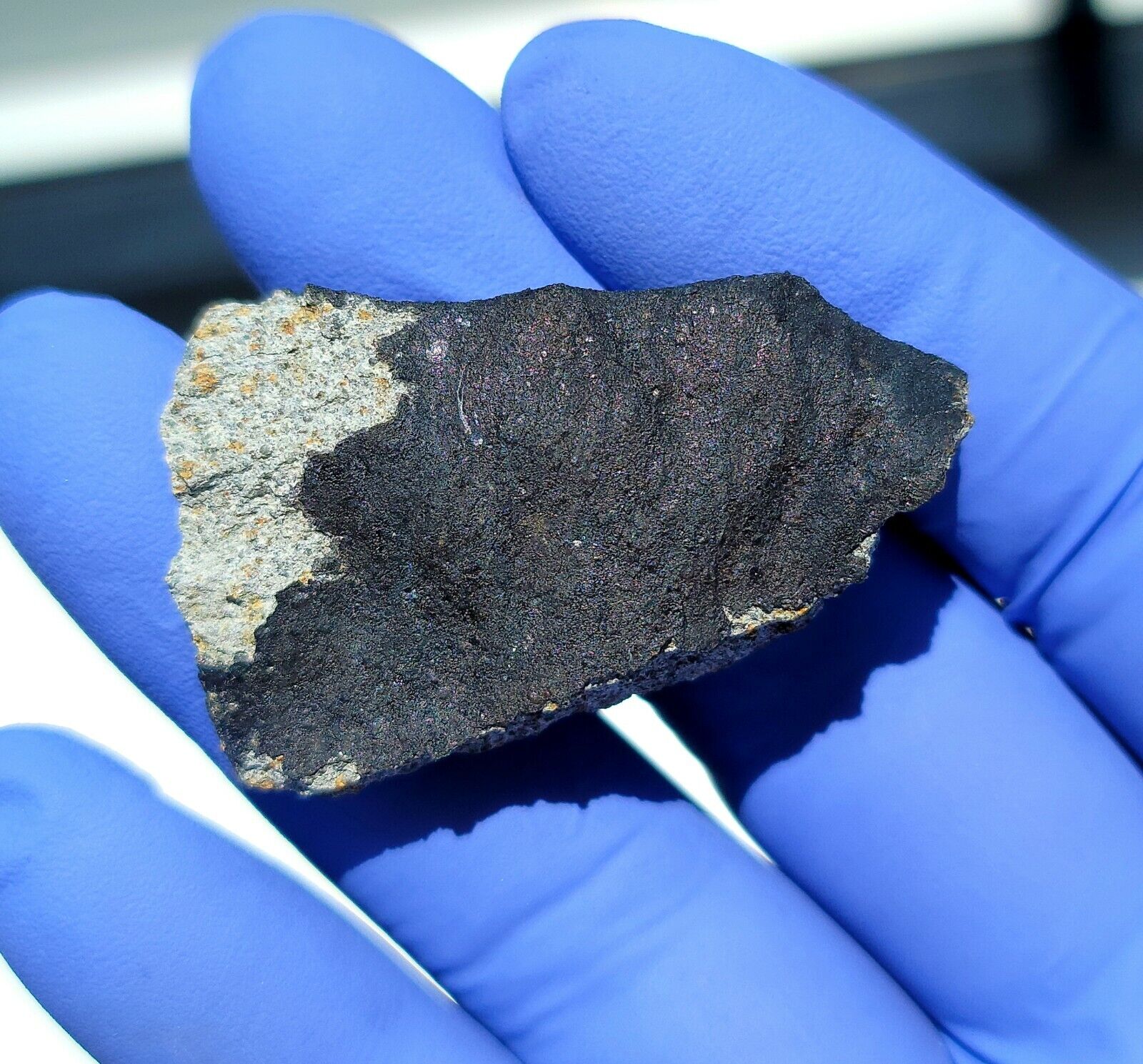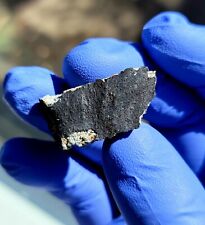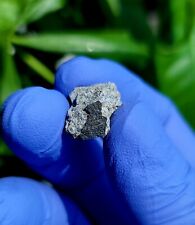Meteorite**Cranfield, Mississippi; H3-5**26.195 gram fresh fragment; NEW FALL

When you click on links to various merchants on this site and make a purchase, this can result in this site earning a commission. Affiliate programs and affiliations include, but are not limited to, the eBay Partner Network.
Meteorite**Cranfield, Mississippi; H3-5**26.195 gram fresh fragment; NEW FALL:
$5999.99
Hello up for sale is one of the newest visitors from space, known so far as Cranfield/Natchez Mississippi meteorite and classified as an H3-5.
This is a 26.195 gram fusion crusted piece with Mississippi mud, freshly picked up off the highway and grass, HAMMER STONE!!!!
On April 27, 2022 at around 8:03 am multiple reports from eye witnessesess in Mississippi, Arkansas, and Louisiana reported a bright daytime fireball followed by several loud sonic booms. This meteorite is currently being researched NASA and classified by several Universities as a joint project. Me "Matthew Stream" and my friend Roberto Vargas flew to Mississippi on April 29th 2022 and decided to hunt for this meteorite. On May 1st at around 9:07 am we discovered a fresh meteorite stone that was smashed up all over highway 98/84. This stone was about 250 grams in total and broken into many pieces, we spent the next couple days recovering pieces and recording its location. We also reported this information to the meteorite community and many other hunters/friends came to join us looking for meteorites. There has been a total of about 8-10 stones recovered with an extremely low weight of less than 500 grams total. This strewnfield was very difficult to hunt, because it is mostly swamps and thick forest vegetation. There were many critters including several types of venomous snakes, lizards, mosquitoes, nats, ticks and much more that made it a challenge to hunt. This meteorite is possibly an L brecciated chondrite and has very fresh black fusion crust and a light grey colored matrix. The analysis is still being done now and classification will be done in the next month or two. I am offering up a few small fragment lots and a couple broken pieces recovered by me, this is a "Hammer stone" and the freshest meteorite on Earth right now. I will include a COA case and display card with every purchase, coordinates will be provided to anyone making a purchase. If you decide you would like more pictures of meteorites with insitu-photos please send me a message. I will also provide an additional COA card for your purchase when the classification is official with the name and type of meteorite. This was my first meteorite find and it was so much fun and an awesome experience I will never forget. Thanks for your interest and take care!
Mississippi, United States
Confirmed fall: 2022 Apr 27
Classification: Ordinary chondrite (H3-5)
History: (M. Fries): On April 27, 2022, at 8:03 a.m. CDT (1303 GMT) multiple eyewitnesses from Arkansas, Louisiana, and Mississippi reported a bolide and sonic booms (AMS Event 2022-2591). Doppler radar data revealed falling meteorites approximately 24 km east of the city of Natchez, Mississippi. The radar reflectivity data overlay rolling hills of dense woodland interspersed with open flat residential areas. Dark-flight modeling suggested meteorites landed both north and south of the divided four-lane U.S. Hwy 84E, next to the sparsely populated subdivision called Cranfield. On April 30, 202,2 Linda Welzenbach Fries and Marc Fries recovered the first two meteorites N1 (41.31 g) and N2 (37.65 g), within the center of the calculated strewn field, 16.9 km east of Natchez, on the shoulder (31°33’06.1"N 91°11’36.6"W) and median (31°33’08.9"N 91°11’25.9"W) of U.S. Hwy 84E. The first stone (N1) remains with the finders. The second stone (N2) is subdivided to provide the required deposit material. Both stones were collected cleanly and prior to rain. On May 1st at around 9:07 a.m. Matthew Stream and Roberto Vargas discovered a meteorite that had hit U.S. Hwy 98/84E (31.550129° -91.206338°, WGS84). This stone is estimated at approximately 250 g in total mass, but is broken into many pieces, recovered over two days. Two pieces from this stone were donated to Cascadia for thin section preparation.
Physical characteristics: Physical Characteristics: (L. Welzenbach Fries): N1 is a 41.31 g lozenge-shaped stone with 90% fusion crust. A small area of broken crust (where it was sitting on the ground) shows a mottled dark-gray matrix with irregular, millimeter-sized lighter grains, clasts and few chondrule fragments with bright, unoxidized finely disseminated metal. Fusion crust is matte black with some chondrule outlines. N2 is a 37.64 g fragment, roughly rectangular in shape and only 50% fusion crust. The exposed interior sheds particles easily, is finely fractured and reveals a dark gray matrix with breccia clasts ranging from millimeters to centimeters in size. Clasts are light gray, irregularly shaped with poorly defined margins. The surrounding mottled matrix contains millimeter-sized irregularly shaped grains and chondrule fragments.
Petrography: (D. Sheikh, M. Hutson, A. Ruzicka, Cascadia): Petrographic and geochemical data were obtained on sample CML 1526 in the Cascadia collection. The first two recovered samples N1 (41.31g) and N2 (37.65 g) were imaged using X-ray computed tomography by S. Eckley at JSC. Total mass of recovered samples is at least 596.83 g (see Samples), but another 500+ grams has been reported through social media but with actual masses and locations unsubstantiated. Regarding the main mass: 122 g fragment is the largest confirmed mass found to date. It is held by Roberto Vargas and Matthew Stream. A notable distinction in color between two lithologies (lighter and darker in color) is observed in thin section in transmitted light. The light lithology displays a chondritic texture with uneven chondrule-matrix integration. Many chondrules can be discerned, with a few having relatively sharp edges. Abundant large (<= 600 μm) metal (with scalloped edges) and sulfide grains are visible; both contain silicate inclusions. Abundant feldspathic-chromite assemblages are also observed. Secondary sodic feldspar (Av. ~20 μm across), chlorapatite, and merrillite are present. The dark lithology displays a brecciated texture composed largely of a texturally and compositionally heterogeneous assemblage of well-defined chondrules (Av. diameter 444±177 μm, n=26) and sub-rounded to angular isolated mineral grains and lithic fragments (both zoned and unzoned) within a fine-grained matrix containing silicates, Fe-Ni metal, troilite, and merrillite. Most chondrules contain a turoffer, devitrified mesostasis, although a few chondrules preserve a primary glassy mesostasis. Red-brown spinel grains are present in two chondrules. In BSE imaging, abundant zoned olivine grains are present, along with Mg-rich olivine and pyroxene, and numerous micro-faults.
Geochemistry: (M. Hutson, D. Sheikh, A. Ruzicka, Cascadia): Light lithology: Olivine Fa18.3±0.2, N=19; Low-Ca pyroxene Fs15.9±0.1Wo1.1±0.2, N=18. Dark lithology: Olivine Fa17.2±8.1 (Fa ranges from 0.5 to 35.6, with median Fa=18.4), N=45; Low-Ca pyroxene Fs11.6±5.5Wo0.8±0.4 (Fs ranges from 0.7 to 16.9, with median Fs=15.6), N=28. Aluminous spinel: Mg# (100*Mg/(Mg+Fe)) = 69.9±4.0 Cr# (100*Cr/(Cr+Al)) = 0.47±0.21, N=4.
Classification: Ordinary chondrite (H3-5). The texture and chemistry of the light lithology is consistent with an H5 ordinary chondrite. For the dark lithology, the chemistry and the presence of devitrified mesostasis in most chondrules, but the preservation of primary glassy mesostasis in some chondrules suggests a moderate subtype between 3.4-3.6.
Specimens: Type specimens-Cascadia received 7.1 g of material, and after thin section preparation, holds 5.7 g in six pieces, as well as 2 polished thin sections and material in an epoxy butt. LPI (XSPACE) recovered 8.3 g and received 8.68 g from Linda and Marc Fries. Confirmed samples from finders: Linda Welzenbach Fries and Marc Fries, 41.31 g and 28.96 g; Roberto Vargas and Matthew Stream, 314 g; Raymond Borges and Ily Valenzuela, 13.9 g; Michael Kelly, 54.3 g; Rob Keeton, 12.5 g; Ashley and John Humphries, 0.1 g; Mark Lyon, 5.6 g; Jason Whitcomb and Howard Lewis, 4.5 g; Steve Arnold, 6.3 g; Cameron and Jody Smith, 10.8 g; L.A. Boltryk, 3.2 g; Tasha Lashea, 0.7 g; Sonny Clary and Loren Mille, 76.58 g.
Data from:
MB111
Table 0
Line 0:
Date:2022 Apr 27
Mass (g):>596.83
Pieces:hundreds
Class:H3-5
Shock stage:S3
Weathering grade:W0
Fayalite (mol%):18.3 (light), 17.2±8.1 (dark)
Ferrosilite (mol%):15.9 (light), 11.6±5.5 (dark)
Wollastonite (mol%):1.2 (light), 0.8±0.4 (dark)
Magnetic suscept.:5.4
Classifier:M. Hutson, D. Sheikh, and A. Ruzicka, Cascadia; L. Welzenbach Fries; S. Eckley, JSC
Type spec mass (g):24.08
Type spec location:Cascadia, LPI
Main mass:Roberto Vargas (Connecticut) and Matthew Stream (California)
Finder:Linda Welzenbach Fries, Marc Fries, Matthew Stream, Roberto Vargas, and others
Comments:Submitted by L. Welzenbach Fries
Meteorite**Cranfield, Mississippi; H3-5**26.195 gram fresh fragment; NEW FALL:
$5999.99

Related Items:
Meteorite**Cranfield, Mississippi; H3-5**26.195 gram fresh fragment; NEW FALL
$9999.99
Meteorite**Cranfield, Mississippi;H3-5**10.805 gram fresh fragment; NEW FALL
$4999.99
Meteorite**Cranfield, Mississippi; H3-5**3.415 gram fresh fragment; NEW FALL
$999.99







